 1. Billboard of Manas in Isfana, overlooking the market, 1995 (that
was the year of Manas).
1. Billboard of Manas in Isfana, overlooking the market, 1995 (that
was the year of Manas).
Elmira: Here I think we may want two or three kinds of things. The one that obviously most directly concerns you is concerning the role of oral tradition and other aspects of traditional culture, especially amongst the Kyrgyz (Manas, artifacts of nomadic life such as yurts; revivals or continuations of certain kinds of ceremonies or rituals, etc.) One way to connect some of this with a broader range of examples is to emphasize the importance of literature (be it oral or written) and language. If that is one key theme, then within such a framework one can also discuss such things as the importance of Ali Shir Navoi for Uzbek ideas about their past, or the importance of Mahmud Kashgari in Xinjiang. I do want to write some about Uzbekistan in particular; but you should not have to do that material--suggestions will be welcome though. Also, I think we need to work into the discussion the impact of independence not only in requiring the creation of new symbols of national identity (flags are an obvious example) but also in requiring that the old symbols be eliminated. Since I happen to have a good sequence of pictures about the removal or alteration of Soviet statues and public art, I will want to include that material. I do plan to talk about the "cult" of Tamerlane; part of such a discussion can be something about the fact that in all or almost all of the Central Asian countries in the 1990s you have had special celebrations of some national cultural or political hero. I get the sense that the Manas celebration was probably a response to the year of Timur the year before. Also, I noted with interest in Tajikistan, as we were driving through on the way to Samarkand, a billboard touting the anniversary celebration (probably 1100 years or so) for the Samanids. It was curious because of the fact their capital was Bukhara, now in Uzbekistan, but a city that is mainly Tajik. So it seemed as though Samanid Bukhara was being coopted to provide historic roots for Tajik greatness...
So, what I am offering here is the whole range of photos I have scanned which can fit within such a broad scheme. As you will note, I don't have a lot to help with nomadic tradition; perhaps you can come up with some other pictures (or ideas of what I should try to find) which would be relevant. I think when we finish this page we will eventually have links to the epic you are translating and also try to have a link to a music file which can be your recitation of part of Manas.
-----------
 1. Billboard of Manas in Isfana, overlooking the market, 1995 (that
was the year of Manas).
1. Billboard of Manas in Isfana, overlooking the market, 1995 (that
was the year of Manas).
 2. Manas
statue in front of National Theater, Bishkek.
2. Manas
statue in front of National Theater, Bishkek.
 3. Manas
"ensemble" (by this I mean the performance space created for the Manas
celebration in Bishkek in 1995--is there a more appropriate name for it?)
3. Manas
"ensemble" (by this I mean the performance space created for the Manas
celebration in Bishkek in 1995--is there a more appropriate name for it?)
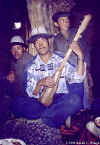 6. Man
playing komus, Kaying Valley, Eastern Pamir, Xinjiang. (Note: it had only two
of the three strings...). Perhaps we could have a tape segment of you playing
it? Also, I have a video I have never looked at on my Mustagh Ata trip (it is in
European format and I have never converted it) which should have some footage of a very
interesting performance by a man who was singing and playing the komus (this was when we
stopped for the night near Tash Rabat). We should look at that and see whether some
part is usable. I had asked the person making the film to copy for me all his extra
footage of the performance; I don't know whether he did.
6. Man
playing komus, Kaying Valley, Eastern Pamir, Xinjiang. (Note: it had only two
of the three strings...). Perhaps we could have a tape segment of you playing
it? Also, I have a video I have never looked at on my Mustagh Ata trip (it is in
European format and I have never converted it) which should have some footage of a very
interesting performance by a man who was singing and playing the komus (this was when we
stopped for the night near Tash Rabat). We should look at that and see whether some
part is usable. I had asked the person making the film to copy for me all his extra
footage of the performance; I don't know whether he did.
 7. Statue
to Uzbek bards, Registan, Samarkand. It would be nice to identify who they are (only
part of the inscription is visible, but presumably some book would have a caption on a
picture of the statue).
7. Statue
to Uzbek bards, Registan, Samarkand. It would be nice to identify who they are (only
part of the inscription is visible, but presumably some book would have a caption on a
picture of the statue).
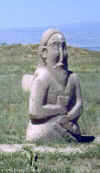 8. Stone statue holding cup, Burana, open air museum. What I
have in mind here (although perhaps this belongs on a different page--e.g., on religion)
is something about the importance of certain social rituals, one of them being to invite
people to share kumyss (which then, of course, has a variety of other ritual
connections). In one of the primary sources (either Babur or Tarikhi Rashidi) there
is an interesting description of such an occasion where one of the nomadic leaders hosted
someone and the occasion was particularly noted because the person being hosted (if I
recall this correctly) had some reservations about drinking anything alcoholic.
However, from the standpoint of diplomacy and manners, he could not refuse. I do
have an image of the consecration of the battle standards, described by Babur, from one of
the Baburnama mansucripts. I could quote both texts, if this would be the place to
do it; also, we could quote Marco Polo for Qubilai's ceremony involving mares. I
believe I read somewhere the view that the cup being held in these statues may well
represent a cup of kumyss. What I am getting at is that one proclaimed aspect of
identity in Central Asia seems to be about norms of politeness and hospitality; of course
that reflects what in fact people encounter--you show up on someone's doorstep or in front
of their yurt, and they are obliged by custom to be hospitable.
8. Stone statue holding cup, Burana, open air museum. What I
have in mind here (although perhaps this belongs on a different page--e.g., on religion)
is something about the importance of certain social rituals, one of them being to invite
people to share kumyss (which then, of course, has a variety of other ritual
connections). In one of the primary sources (either Babur or Tarikhi Rashidi) there
is an interesting description of such an occasion where one of the nomadic leaders hosted
someone and the occasion was particularly noted because the person being hosted (if I
recall this correctly) had some reservations about drinking anything alcoholic.
However, from the standpoint of diplomacy and manners, he could not refuse. I do
have an image of the consecration of the battle standards, described by Babur, from one of
the Baburnama mansucripts. I could quote both texts, if this would be the place to
do it; also, we could quote Marco Polo for Qubilai's ceremony involving mares. I
believe I read somewhere the view that the cup being held in these statues may well
represent a cup of kumyss. What I am getting at is that one proclaimed aspect of
identity in Central Asia seems to be about norms of politeness and hospitality; of course
that reflects what in fact people encounter--you show up on someone's doorstep or in front
of their yurt, and they are obliged by custom to be hospitable.
9. Baburnama pic. of consecration of standards.
----------
Here, another topic: who are the heroes of one's national history apart from the epic ones? Obviously we need some context, which could be simply a brief paragraph or two about those who were officially or popularly (the two may differ obviously) venerated as national heroes. The one example I have for illustration is the grave site of Turdali Mergen, who was, apparently, the leader of the last Basmachi resistance in S. Kyrgyzstan in the mid-1930s. I don't have any details on him, but perhaps you could find an entry in a Kyrgyz encyclopedia. Of course the Basmachi were suppressed and only negative things were written about them in the Soviet period, but with independence, they can openly be discussed and memorialized. I'm sure we could use some other examples of people who were victims of the purges; also the changes in attitudes about something like Manas would fit into this discussion. It would be interesting, of course, to know to what degree some of the historical revisionism is based on documentable fact, or to what degree it might be imagined. I don't know about the historicity of Mergen's last stand, although presumably it should be documentable.
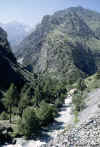 10. The
location of Mergen's last stand, at the intersection of the Uryam and Layalik Rivers,
Pamir-Alai.
10. The
location of Mergen's last stand, at the intersection of the Uryam and Layalik Rivers,
Pamir-Alai.
 11.
Mergen's grave, at the foot of the rocky spur in the previous photo. Apparently
this was not there in 1995-96. My photo comes from 1999.
11.
Mergen's grave, at the foot of the rocky spur in the previous photo. Apparently
this was not there in 1995-96. My photo comes from 1999.
 12.
"Mergen's House" (Mergendin uyi--I'm not sure of the transliteration
here). In the open area where the rivers meet there is now a little shepherd's hut,
which had not been there earlier. While we were told it is simply a campsite, along
with the other graffiti on the rocks, one can see the identification of the location as
"Mergen's House."
12.
"Mergen's House" (Mergendin uyi--I'm not sure of the transliteration
here). In the open area where the rivers meet there is now a little shepherd's hut,
which had not been there earlier. While we were told it is simply a campsite, along
with the other graffiti on the rocks, one can see the identification of the location as
"Mergen's House."
-------------
Here I get into the Uzbek material that, by and large, I can write about. Any ideas you have for it would be helpful though.
 13.
Government building in center of Tashkent with banner for anniversary of
independence. The banner reads (I think I have this accurately): Kuchli
davlat, kuchli jamiyat quraniz! (Translation, please...)
13.
Government building in center of Tashkent with banner for anniversary of
independence. The banner reads (I think I have this accurately): Kuchli
davlat, kuchli jamiyat quraniz! (Translation, please...)
 14.
Alisher Navoi poster on hotel, on occasion of the anniversary in 1991 (it would have been
something like 500th anniversary since his death?). Prof. Cirtautas gave a paper
there at the conference held on the occasion. The inscription on the banner (at
least the Uzbek part of it reads: Tilga tiersiz elga z tiborsi (which means?).
I plan to write something on who he was, and how he does or does not really fit into the
pantheon of Uzbek writers. Among other things, I can quote what Babur says about him
as a writer.
14.
Alisher Navoi poster on hotel, on occasion of the anniversary in 1991 (it would have been
something like 500th anniversary since his death?). Prof. Cirtautas gave a paper
there at the conference held on the occasion. The inscription on the banner (at
least the Uzbek part of it reads: Tilga tiersiz elga z tiborsi (which means?).
I plan to write something on who he was, and how he does or does not really fit into the
pantheon of Uzbek writers. Among other things, I can quote what Babur says about him
as a writer.
For analogies, I can do something with two very important Turkic literary figures who are commemorated in Xinjiang: Yusuf Hass Hajib and Mahmud Kashgari. Of course there the government is also very much behind the promotion of them as cultural heroes, but I think in a very carefully controlled way to make sure that at the same time they would not be construed as paragons of an independent Uighur identity. Probably it is impossible to prevent their being used in that way if they are going to be mentioned at all.
 15. The
tomb (recently constructed) of Yusuf Hass Hajib, Kashgar.
15. The
tomb (recently constructed) of Yusuf Hass Hajib, Kashgar.
 17.
Detail from poster display at tomb complex, extolling governent and party support for the
reconstruction project.
17.
Detail from poster display at tomb complex, extolling governent and party support for the
reconstruction project.
 18. Statue
to Mahmud Kashgari at entrance to his tomb complex, Wu Paer, 50 km. south of Kashgar.
18. Statue
to Mahmud Kashgari at entrance to his tomb complex, Wu Paer, 50 km. south of Kashgar.
 19.
Kashgari's tomb. As in the case of that of Yusuf Hass Hajib, the building is a
recent structure.
19.
Kashgari's tomb. As in the case of that of Yusuf Hass Hajib, the building is a
recent structure.
 21. Map
appended to Kashgari's Dictionary. This photo is taken from the reproduction of the
map in the Ulugh Beg museum in Samarkand. What is interesting here is the idea of
how one places in the center of the world one's home town or most important city.
Balasaghun is the one closest to the center here; Kashgar off to its right (they are
designated by B and K on the detail of the map, next picture). I think this can
allow for some additional discussion and possibly other examples. It is ironic that
only a few years earlier in that same museum in Samarkand, I noticed that the "edited
version of the map they had on the wall placed Samarkand at the center (instead of the
correct Balasaghun). Someone must have called them on that falsification of the
document; so they corrected the distortion.
21. Map
appended to Kashgari's Dictionary. This photo is taken from the reproduction of the
map in the Ulugh Beg museum in Samarkand. What is interesting here is the idea of
how one places in the center of the world one's home town or most important city.
Balasaghun is the one closest to the center here; Kashgar off to its right (they are
designated by B and K on the detail of the map, next picture). I think this can
allow for some additional discussion and possibly other examples. It is ironic that
only a few years earlier in that same museum in Samarkand, I noticed that the "edited
version of the map they had on the wall placed Samarkand at the center (instead of the
correct Balasaghun). Someone must have called them on that falsification of the
document; so they corrected the distortion.
23. Here I think it would be appropriate to include a picture of the Tower of Burana, since if you go there now, you are told that it in fact is the location of Balasaghun. Whether there is any agreement on that is something I don't yet know--I would like to know whether that might not be to some degree an invented history, in the given instance, for Kyrgyz national purposes. On the face of it, the identification is logical enough, of course.
----------
I want to talk about the way monuments are altered; this can then lead to important points about the invocation of earlier history, in particular the "cult of Tamerlane" one now sees being promoted in Uzbekistan.
 24. The
base where once there was a statue of Dzerzhinsky, the founder of the Cheka,
Tashkent. This was the first Soviet monument to come down in Tashkent, only days
after the declaration of independence in 1991. It stood in the park right next to
the KGB headquarters, which is, of course, still KGB (Uzbek style) headquarters.
24. The
base where once there was a statue of Dzerzhinsky, the founder of the Cheka,
Tashkent. This was the first Soviet monument to come down in Tashkent, only days
after the declaration of independence in 1991. It stood in the park right next to
the KGB headquarters, which is, of course, still KGB (Uzbek style) headquarters.
![]() 25. Detail
of same, where one can see the bolt holes that had held in place the lettering identifying
Dzerzhinsky.
25. Detail
of same, where one can see the bolt holes that had held in place the lettering identifying
Dzerzhinsky.
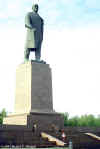 26.The statue
of Lenin, in what had been Lenin Square, Tashkent. Although the square was almost
immediately re-named "Independence Square," the statue remained in place for a
while while a competition was being held for a replacement. The photo is from
September or early October 1991, within a month or so of independence.
26.The statue
of Lenin, in what had been Lenin Square, Tashkent. Although the square was almost
immediately re-named "Independence Square," the statue remained in place for a
while while a competition was being held for a replacement. The photo is from
September or early October 1991, within a month or so of independence.
 27. The
replacement monument to Uzbek independence, on the same pedestal that had held the Lenin
statue. The dimensions of this globe with a raised outline of a hugely enlarged
Uzbekistan on it, are such that it looks rather like a golf ball. At least the Lenin
statue was proportionate to the base.
27. The
replacement monument to Uzbek independence, on the same pedestal that had held the Lenin
statue. The dimensions of this globe with a raised outline of a hugely enlarged
Uzbekistan on it, are such that it looks rather like a golf ball. At least the Lenin
statue was proportionate to the base.
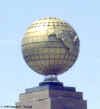 28.
Detail, showing the outline map of Uzbekistan. There is an obvious parallel here
with the Kashgari map above, with such things as medieval maps of the known world which
had Jerusalem (the quintessential holy city) at the center, etc. Also,
advertisements for Uzbek airlines in the Uzbek air magazine have all flights converging on
Tashkent, exactly in the center of the world. Note as well, American maps of the
world invariably split Eurasia in order that the Americas can be precisely in the
center....
28.
Detail, showing the outline map of Uzbekistan. There is an obvious parallel here
with the Kashgari map above, with such things as medieval maps of the known world which
had Jerusalem (the quintessential holy city) at the center, etc. Also,
advertisements for Uzbek airlines in the Uzbek air magazine have all flights converging on
Tashkent, exactly in the center of the world. Note as well, American maps of the
world invariably split Eurasia in order that the Americas can be precisely in the
center....
 29. The
relief sculpture over the entrance to the subway station that had been "Ploshchad'
Lenina." In post-independence 1991, the station name had been changed but not
yet the relief sculpture, which still features Lenin in the center, against a backdrop of
a flag reading "Vsia vlast' sovetam!" (All Power to the Soviets), and an
inscription on the left: "Skvoz' grozy siialo nam solntse svobody."
(Something like: Through the storm the sun of freedom shone on us.) Presumably
this is a kind of apotheosis of Lenin (analogies the representations of Louis XIV as the
Sun). When they finally got around to changing the relief (by 1999--I don't know
exactly when it was done), the figures at the far left of the original were enlarged and
placed in the center in place of Lenin. To the left, the inscription was removed,
and the new Uzbek flag became part of the backdrop. But on the right the old flag
was left in place, and they simply chiseled away most of the lettering (ironically one can
still see traces of "vlast' sovetam," which might be taken as symbolic of the
relationship between the current Uzbek government and what preceded it--that is, on the
surface things are different, but they really are the same... Note, I will probably
create a display where the sets of images will be side-by-side for easy comparison of the
details.
29. The
relief sculpture over the entrance to the subway station that had been "Ploshchad'
Lenina." In post-independence 1991, the station name had been changed but not
yet the relief sculpture, which still features Lenin in the center, against a backdrop of
a flag reading "Vsia vlast' sovetam!" (All Power to the Soviets), and an
inscription on the left: "Skvoz' grozy siialo nam solntse svobody."
(Something like: Through the storm the sun of freedom shone on us.) Presumably
this is a kind of apotheosis of Lenin (analogies the representations of Louis XIV as the
Sun). When they finally got around to changing the relief (by 1999--I don't know
exactly when it was done), the figures at the far left of the original were enlarged and
placed in the center in place of Lenin. To the left, the inscription was removed,
and the new Uzbek flag became part of the backdrop. But on the right the old flag
was left in place, and they simply chiseled away most of the lettering (ironically one can
still see traces of "vlast' sovetam," which might be taken as symbolic of the
relationship between the current Uzbek government and what preceded it--that is, on the
surface things are different, but they really are the same... Note, I will probably
create a display where the sets of images will be side-by-side for easy comparison of the
details.
![]() 31. Detail
of inscription on flag, 1991.
31. Detail
of inscription on flag, 1991.
 33.
Inscription, left side, 1991 (detail of preceding photo).
33.
Inscription, left side, 1991 (detail of preceding photo).
 35.
Detail, center, 1999. The modern Uzbek flag is clearly visible here.
35.
Detail, center, 1999. The modern Uzbek flag is clearly visible here.
 36.
Detail, rest of flag (right side), 1999.
36.
Detail, rest of flag (right side), 1999.
 37.
Detail, left side (inscription absent).
37.
Detail, left side (inscription absent).
38. I think it will make sense to have an image of the Uzbek flag in color; I want to translate a bit of the newspaper article published in 1991 not too long after the declaration of independence telling people about the new flag and explaining its symbolism, in part with reference to nature, the Islamic past, Timur's empire, etc. If you can find a similar official explanation for the Kyrgyz flag, a picture of which we should include above, that would be nice. I may also do a scan of the front page of the newspaper which I have from Sept. 1, 1991, proclaiming Uzbek independence.
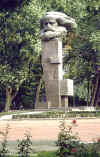 39. Bust
of Marx in central park, Tashkent, 1991.
39. Bust
of Marx in central park, Tashkent, 1991.
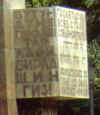 40.
Detail of the legend. May not really need to include photo.
40.
Detail of the legend. May not really need to include photo.
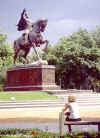 41.
Statue of Tamerlane which replaced Marx.
41.
Statue of Tamerlane which replaced Marx.
 42. Detail
of inscription. This photo is not really clear enough and probably should not be
included in final page. I'm curious, what exactly is the Uzbek wording?
I can make out: _uc - adoletd(?)e_ur, which means Strength in Justice or Sila v
spravedlivosti.
42. Detail
of inscription. This photo is not really clear enough and probably should not be
included in final page. I'm curious, what exactly is the Uzbek wording?
I can make out: _uc - adoletd(?)e_ur, which means Strength in Justice or Sila v
spravedlivosti.